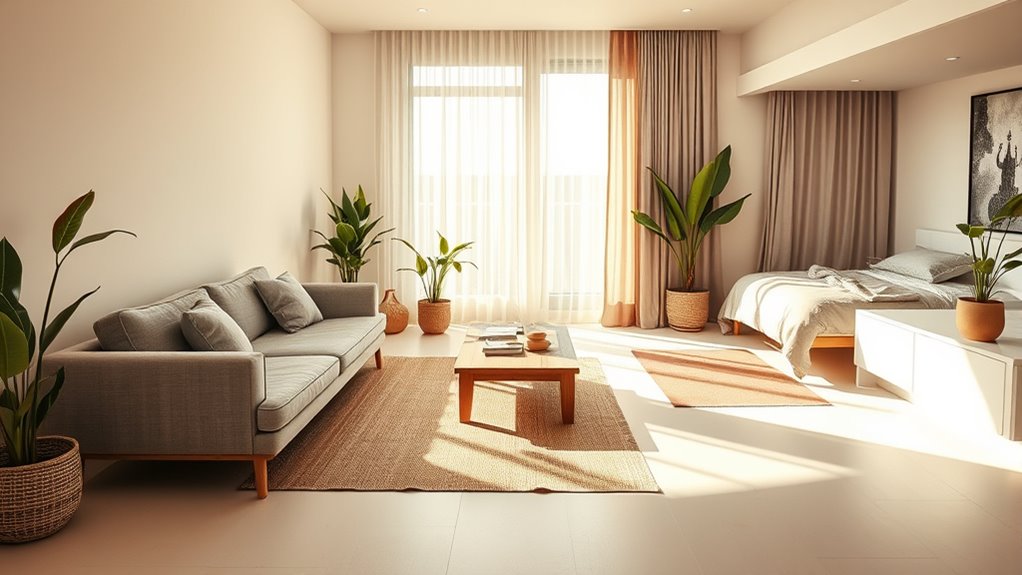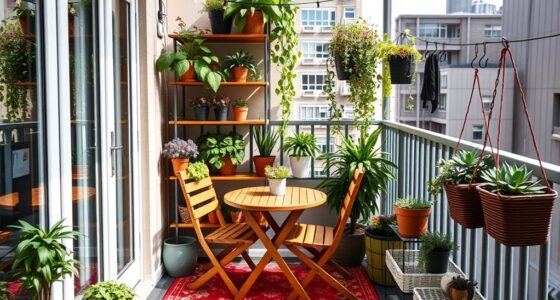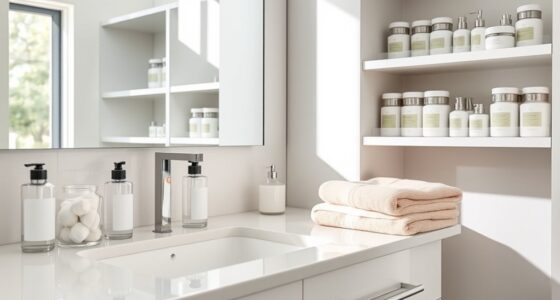To create distinct zones in your studio apartment without walls, you can strategically use furniture, lighting, and privacy features. For example, a sectional sofa or bookshelf can define your living space, while rugs and curtains help separate areas like your bed or workspace. Thoughtful placement of lighting enhances visual separation, making each zone feel cozy yet open. Keep exploring different furniture and design tips to master zoning and turn your small space into a functional, stylish home.
Key Takeaways
- Use furniture placement like sectional sofas and bookshelves to visually define different functional zones.
- Incorporate area rugs and strategic lighting to create distinct, inviting spaces within an open layout.
- Employ flexible privacy solutions such as curtains, screens, or tall cabinets to separate sleeping and work areas.
- Maintain natural light flow by avoiding bulky furniture blocking windows, enhancing openness and spatial perception.
- Focus on contrast, depth, and purposeful layout to achieve clear, functional zones without physical walls.

Are you wondering how zoning laws affect the layout and design of studio apartments? While zoning typically governs larger developments and land use, its principles can influence how you organize your space, especially when it comes to maximizing functionality within limited square footage. In a studio apartment, zoning concepts aren’t just about legal boundaries—they’re about creating distinct zones that serve different purposes without the need for walls. This is where strategic furniture placement and thoughtful privacy solutions come into play.
Maximize your studio space with strategic zoning through furniture placement and privacy solutions, creating distinct, functional areas without walls.
You can transform your open layout into separate areas by carefully choosing and positioning furniture. For instance, a sectional sofa can double as a divider, visually separating the living space from the sleeping area. Tall bookshelves or open shelving units serve a similar purpose, acting as natural barriers that define zones without blocking light or airflow. When placing furniture, consider how each piece can act as a boundary—an area rug under the dining table, a bed with a headboard, or a desk that creates a visual separation. These arrangements help establish distinct functions within the same space, giving each zone a sense of purpose and privacy.
Privacy solutions are essential in a studio apartment, especially if you work from home or need quiet zones. You don’t need walls to create privacy; instead, use clever design elements. Folding screens, curtains, or room dividers can be easily moved or adjusted to shield your sleeping area from the rest of the apartment when needed. These temporary solutions provide visual separation and help block noise, making your space feel more like individual rooms. Another approach is to elevate or partition areas with furniture—placing a bookshelf or a tall cabinet between zones creates a physical boundary that offers both privacy and storage. Additionally, understanding the importance of contrast ratio can help you choose lighting and decor that enhance the perception of separation and depth within your zones.
Natural light is another factor influenced by how you zone your space. Keep pathways clear and avoid blocking windows with bulky furniture, so your apartment remains bright and airy. Strategically placing furniture not only enhances privacy but also encourages better flow and functionality. Remember, zoning in a studio isn’t about rigid separations; it’s about creating a seamless flow that feels organized, private, and adaptable to your needs. With clever furniture placement and privacy solutions, you can enjoy the benefits of a well-designed studio apartment that maximizes every inch without sacrificing comfort or style.
Frequently Asked Questions
How Can I Maximize Space in a Small Studio Apartment?
To maximize space in a small studio apartment, focus on smart furniture arrangement and light color schemes. Use multi-functional furniture like fold-out beds or storage ottomans to save space. Keep your color schemes light and neutral to make the area feel larger and more open. Arrange furniture to create distinct zones without walls, ensuring each area has a purpose while maintaining an airy, uncluttered look.
What Are the Best Lighting Options for Zoning Areas?
Imagine your space transforming effortlessly—your lighting choices play a key role. You should harness natural light to define zones, making your areas feel open and inviting. Complement this with ambient lighting, like soft overhead fixtures or floor lamps, to create a cozy atmosphere. By layering these options, you’ll visually separate your zones without walls, maximizing your studio’s functionality and ambiance, all while keeping it bright and welcoming.
Can Temporary Room Dividers Be Moved Easily?
Temporary room dividers, like freestanding dividers and movable panels, are designed for flexibility. You can easily move them around your space without much effort, allowing you to reconfigure your layout quickly. These options are lightweight and portable, making it simple to create different zones or privacy areas on a whim. Whether you’re dividing a living space or creating a temporary workspace, these dividers help you customize your environment effortlessly.
How Do I Maintain Privacy Without Walls?
Ever wonder how you can keep privacy without walls? You can use portable privacy screens or acoustic panels to create distinct zones in your space. These options are flexible, affordable, and easy to move around. Do you really need permanent walls to feel secluded? With these solutions, you maintain your privacy while keeping your studio open and adaptable to your needs. It’s all about smart, temporary partitions.
What Are Cost-Effective Zoning Solutions for Renters?
To find cost-effective zoning solutions, you can use multifunctional furniture and strategic placement to define different areas. Adding acoustic treatments helps reduce noise transfer, enhancing privacy. Incorporate urban gardening as a natural barrier to separate spaces and add greenery. These solutions are affordable, flexible, and allow renters to create distinct zones without permanent walls, making your apartment more comfortable and functional without breaking the bank.
Conclusion
By using clever zoning techniques, you can transform your studio into a welcoming, multi-functional space without adding walls. Think of it as painting a vivid picture on a blank canvas, where each zone is a brushstroke that defines your lifestyle. With a little creativity and strategic planning, your small space can feel like a cozy mansion, seamlessly blending different areas into one harmonious home. Embrace these ideas, and watch your studio come alive with personality and purpose.








